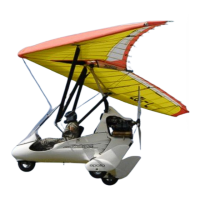6.7.6 Stalling
In practice, in level flight it is only possible to induce a nose down stall at high take
off weights. Moving it slowly the control bar can be pushed ahead until it reaches the
nose tube. The beginning of stall is indicated by a significant increase in control bar
loads. The aircraft trembles a little bit, seeks to turn either to left or right and only
strong control bar movements can keep the straight direction. When pushing out the
control bar in a quicker way the following stall will be more radical. The aircraft begin
a steep dive with nose down angle of 45 degree.
Recovery from a mild stall is very gentle; either power is on or off. Recovery is quick,
with height loss of less than 20 meters. A violently forced stall induces a danger.
Never stall with the nose pitched up too high. This can result in a tail slide followed
by a tumble. As a guideline, the nose up angle at which the ultralight stalls is about
the nose down angle it will recover at.
Recovery occurs even if the control bar is kept pulled in. The control bar is to be
released out cautiously; otherwise a steep stall follows the automatic recovery. The
release of the control bar is to be slow, because otherwise the angle of attack
increases to high values, speed decreases quickly and the following new stall can be
even steeper than the preceding one.
Practicing stalls is prohibited. Only gentle stalls can be practiced only supervised by
an instructor as an official part of the training. Stalling in a turn or in spiral the
following movement is even more radical. As the minimum speed of the aircraft
increases with the growing of the seat loading and the bank, therefore in a turn this
limit is to be kept strictly.
6.7.7 Gliding
Gliding is possible either with the motor running or with the motor stopped. In both cases
the airspeed is to be considered. When flying close to the maneuvering speed or above it
rough control movements are not allowed. When gliding watch the temperature and if the
motor is operating, keep the motor temperature above the minimum by giving some gas
from time to time. No resonance is generated if gliding speed and gas are synchronized.
With the motor stopped the airflow around the propeller turns it slowly while causing a tail-
heavy torque, which is to be considered especially if flying with a speed close to the
minimum. In this case do not allow the aircraft to slow down under the minimum speed!
6.7.8 Stopping the motor and restarting it in the air
In flight the ignition switches can stop motor. The motor lives longer if before stopping it is
cooled back especially if it is warm and being high enough. When restarting set the
switches to ON and either pull the starter handle strongly or push the starting button of the
self-starter. If the motor is below the allowed minimum activate the choke and give no gas.
Motor starts easily at a gliding speed of about 70 km/h. Close to the ground (below 2 – 5
meter) consider that when starting the motor the generated torque may disturb keeping
the flight path correctly.

